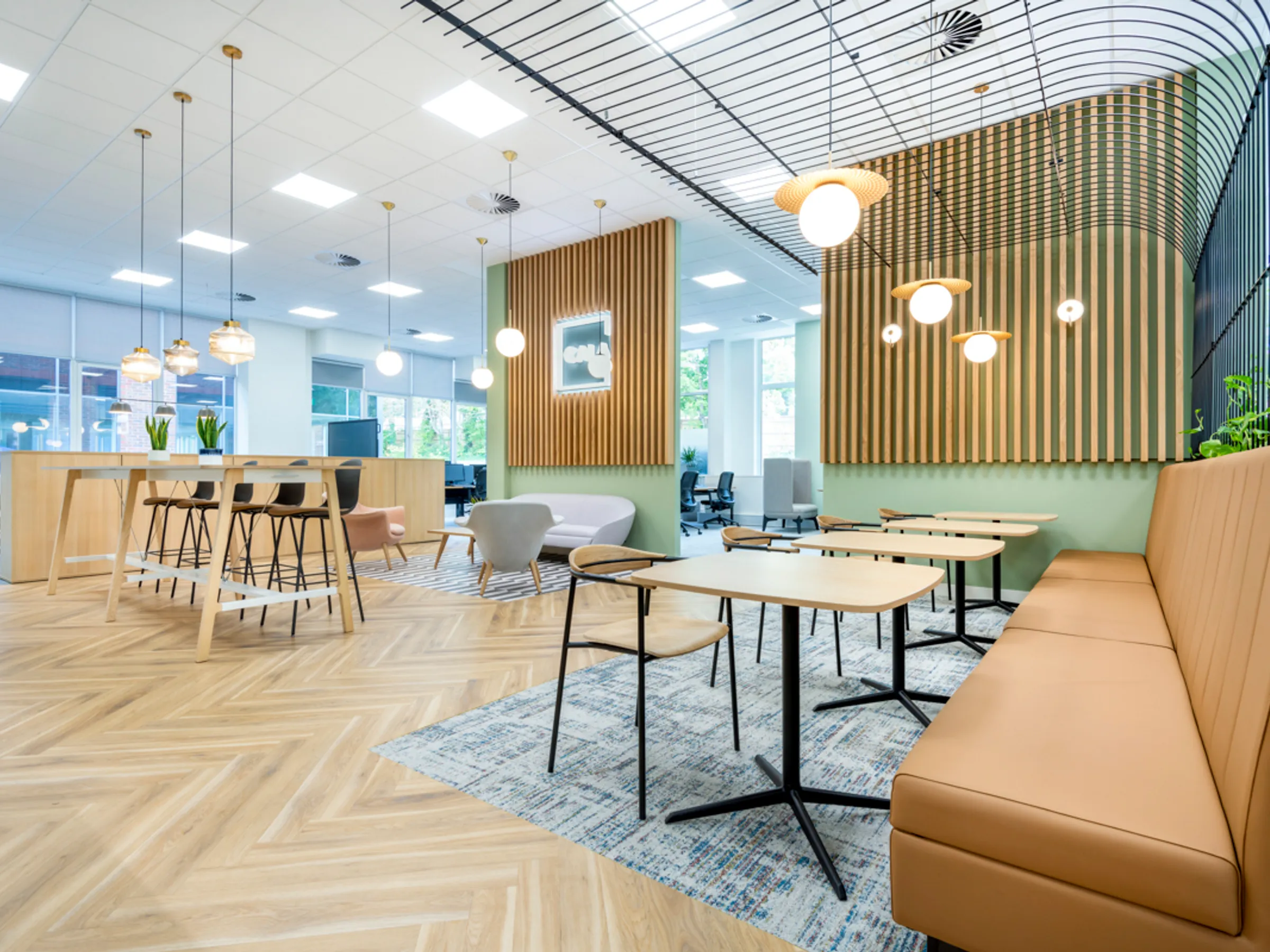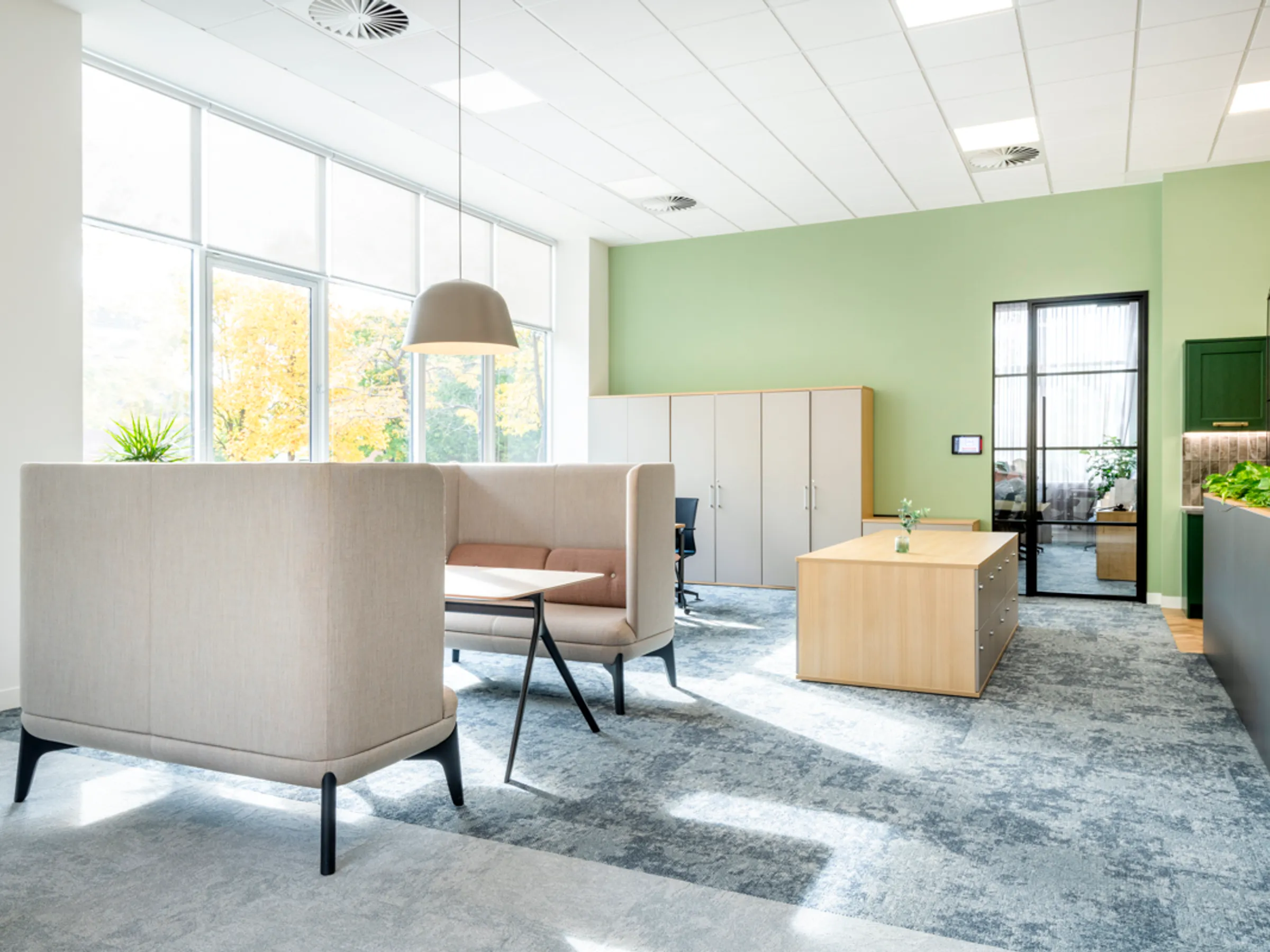Investing in a Furniture Consultant: ROI Explained
Furnishing is one of the final steps in putting a new workplace together, and all too often, it’s considered an afterthought at the end of a long, costly outfitting project. For businesses working with a tight budget, it’s easy to think furniture can be a slap-dash job, especially if you already have units from a previous office space.


Written by
Fritha Selwyn Jones
Contents
Furnishing is a vital element of any workplace, profoundly affecting the atmosphere and functionality of the space. Beyond logistical benefits like tech integration, accessibility, and ergonomics, carefully selected furniture can reinforce brand and team culture, boost mental health and wellness, and simply give people motivation and excitement about coming to work.
The return on investment in workplace furniture goes further than saving on decorating. Making the right choices means your office design project will produce better results for your team and brand. In the long run, it’s worth investing in a furniture consultant. Here’s why.

How is a return on investment calculated?
Workplace furnishing consultancy is more than just aesthetics. Here’s a basic formula for calculating ROI:

In the context of furniture consultancy, the total costs cover direct and indirect expenses, including:
Fee for consultancy
Cost of furniture
Cost of business operations downtime
Costs of third parties (e.g. shipping, installation, customisation)
Maintenance costs (e.g. upkeep, repairs, replacements expected as part of the furnishing solution)
Calculating the cost of a workplace furnishing project is fairly straightforward, and your consultancy can provide you with a breakdown of these costs if needed. Quantifying the project's benefits to calculate ROI requires a little more work.
Total benefits are assessed quantitatively and qualitatively. Here’s a breakdown of how benefits can be objectively measured:
1. Increased productivity: this looks different to all businesses but generally is measured through improved output, decreased time to complete tasks and projects, and increased revenue per employee.
Increased Productivity=(New Output−Old Output)×Monetary Value per Unit of Output
2. Cost savings:
Better ergonomics and wellbeing-led design result in lower levels of absenteeism, which leads to healthier bodies and minds and fewer sick days.
Savings from Reduced Absenteeism=Reduction in Sick Days×Daily Cost per Employee
3. Lower employee turnover reduces recruitment and training costs due to improved employee satisfaction and retention.
Savings from Lower Turnover=(Old Turnover Rate−New Turnover Rate)×Cost per Replaced Employee
4. Energy savings from reduced utility costs result in better energy efficiency thanks to furnishings.
Energy Savings=Reduction in Utility Bills Over Time
5. Revenue impact:
Better impressions on clients result in increased client retention and higher conversion rates for client pitches thanks to furnishing, which instils a stronger brand image and facilitates better meetings and presentations.
Increased Revenue=Increase in Conversion Rate×Average Deal Size
6. Long-term value, such as durability, reduces the need for frequent replacements, which can be seen as a depreciating cost benefit over the furniture's lifespan.
Long-Term Value Savings=Replacement Cost Avoided/Expected Lifespan of New Furniture
How to Calculate ROI Based on This Approach
Once all costs and benefits are quantified, calculate the net benefit:
Net Benefit=Total Benefits−Total Costs
Plug the net benefit and total costs into the ROI formula:
ROI=Net Benefit/Total Costs×100
Hypothetical Calculation
A business chooses to hire a furniture consultant at a fee of £10,000, and the total cost of new furniture is £50,000. The expected benefits include:
Productivity Increase: Valued at £30,000 annually.
Reduced Absenteeism: Saving £5,000 annually.
Lower Turnover: Saving £15,000 annually.
Enhanced Client Conversion: Expected to increase revenue by £10,000 annually.
Long-Term Durability: Expected to save £10,000 over five years in replacement costs.
Total Annual Benefits = £30,000 + £5,000 + £15,000 + £10,000 = £60,000
Total Costs = £10,000 (consultant fee) + £50,000 (furniture) = £60,000
Net Benefit = £60,000 (annual benefits) - £60,000 (total costs) = £0 in the first year.
But if we look over a five year period, where furniture costs are amortised and benefits are recurring:
Net Benefit (5 years) = £300,000 (benefits over 5 years) - £60,000 (initial costs) = £240,000
ROI (5 years):
ROI=(240,000/60,000)×100=400%
This means the business would achieve a 400% return on their initial investment over five years. Due to some of the more qualitative and subjective benefits concerning employee wellbeing, client experience, and employee turnover, it’s tough to know where furniture consultant ROI's true, accurate impacts lie. Still, if we follow this process, we can track changes to understand where costs are saved and where furnishing projects are more impactful—great information for optimising the impact of following changes and developments in the future.


Long-term Savings
While hiring a furniture consultant will require more upfront expense, long-term savings and impact on enhancing brand image make it worthwhile.
Budget Management
Getting the best value for a budget is at the top of all businesses’ priority lists, and this is where a furniture consultant can really help. Where budgeting for furniture comes in, an industry expert can help you make more informed decisions about costs, quality, and functionality. With project requirements in mind, a consultant can identify materials, brands, and opportunities that make the most of a budget.
Generally, consultants also have established relationships with suppliers and designers, meaning they can access industry deals and negotiate better prices, terms, and discounts that businesses might not be able to secure on their own.
Time Savings
Handling furnishing yourself means you don’t have to pay for the cost of a professional, but it also means extra time and resources have to be dedicated directly to the task. A consultant manages this entire process when they step into the project. Often having been involved from the early stages, they already have a contextual awareness of the project, the space, and the budget.
A consultant will manage the entire process, from planning to design, purchasing, and installation. This saves businesses time as they can focus on operations while the furnishing project is carried out in the background.
Consultants are trained to support your daily business functions by finding and executing the least disruptive solutions. Their experience means avoiding pitfalls and delays that might otherwise be unforeseen, ensuring the project stays on schedule.

Boosted Employee Morale
Return on investment depends significantly on the space's impact on the people who use it, and this is truly central to the work of a good furniture consultant. Workers should benefit from the space in every way needed to ensure the workplace is welcoming, happy, and productive.
A well-furnished workspace should meet standards for health and wellbeing. It should be comfortable—physically and mentally—to reduce fatigue, strain, stress, and health issues. Well-selected furniture that hits these targets means fewer sick days, higher levels of productivity, and better-quality work.
How can we measure return on investment through employee perception?
Metric | How This is Measured |
Employee Satisfaction | Pre- and post-implementation surveys assessing overall satisfaction with the workspace. |
Perceived Productivity | Self-reported productivity levels through surveys before and after the redesign. |
Objective Productivity | Analysis of quantitative productivity data (e.g., output per employee, project completion times) before and after the redesign. |
Physical Comfort | Surveys and feedback on ergonomic issues. Reduced reported discomfort such as back pain, eye strain, etc. |
Absenteeism Rates | Tracking absenteeism rates before and after the redesign to see if there is a reduction. |
Mental Health and Stress Levels | Survey questions related to stress levels and overall mental well-being. Comparing before and after results. |
Employee Retention | Analysis of turnover rates before and after the redesign, and feedback from exit interviews on the influence of the workspace on retention decisions. |
Employee Engagement | Regular employee engagement surveys assessing changes in engagement levels post-redesign. |
Collaboration and Communication | Surveys and feedback on collaboration and communication within the new workspace and observations of changes in team dynamics. |
Management and Peer Observations | Qualitative feedback from managers and peers on changes in behaviour, morale, and overall atmosphere. |
Corporate Culture Alignment | Assessment of how well the new space aligns with company values through employee feedback and observation. |
Brand Ambassadorship | Monitoring external comments and feedback from employees about the workspace, including social media posts and informal conversations. |
Morale, satisfaction, and loyalty are also impacted by workplace furnishing. A space that reflects the brand people have chosen to work for, showing it in its best, most authentic, and confident light, tastefully showing off its values and demonstrating a high level of care and consideration for those who use the space results in happier employees who look forward to coming to work.


Brand Perception Amplified
With the right furniture, not only the staff will have a memorable positive experience entering the space. Brand perception extends to all those who visit: clients coming in for their first meeting, contractors you’re negotiating work with, investors whose decisions will affect the business—any stakeholders. They will all have a certain perception of the brand when they enter the space.
Techniques Furniture Consultants Use
How is furniture used to holistically present the brand in the very best light?? This is where a professional consultant can make a significant difference using certain techniques that would be missed or misjudged by a non-professional:
Strategic design alignment that translates company brand identity into tangible design elements.
Developing custom solutions that embody the brand using supplier networks, tools, and skills.
Mapping visitor journeys through the space to determine zoning, wayfinding, flow, interaction points, and accessibility.
Identifying key ergonomic and accessibility demands for the business and meeting them with the proper solutions.
Using in-depth knowledge of materials, finishes, and manufacturing processes to meet quality and sustainability requirements in a cost-saving way.
Harnessing consistency across all furnishing solutions and spaces for a harmonious design that reinforces a brand image.
Storytelling through design to convey brand history, values, and intentions.
Understanding how to meet diverse user groups' needs and expectations to satisfy workers, clients, and other visitors.
Future-proofing the space with furniture guaranteed to last, extending the budget by putting off replacements and repairs.
Find out more about furniture consultancy in our blog, or get in touch for a quote so we can explain our approach to ROI.
Published on
August 29, 2024
Related Articles















